Subject of a recent TextileArtist.org article and co-author of ‘Connected Cloth’ (with Cas Holmes), Anne Kelly has some experience of both curating exhibitions and submitting art to galleries solo and in groups. We’re extremely grateful to Anne for sharing her expertise in this article, which presents her practical advice for hanging textile art and aims to help you display your work as successfully as possible.

Presenting, displaying and hanging your work as a textile artist has the potential to be challenging and at times confusing! There are such a variety of formats for different scales of work and media that it can be tricky to decide which one works best for you and your pieces. In our forthcoming book Connected Cloth, Cas Holmes and I explore a range of options and some of these are documented in the section ‘Connections and Collaborations’.
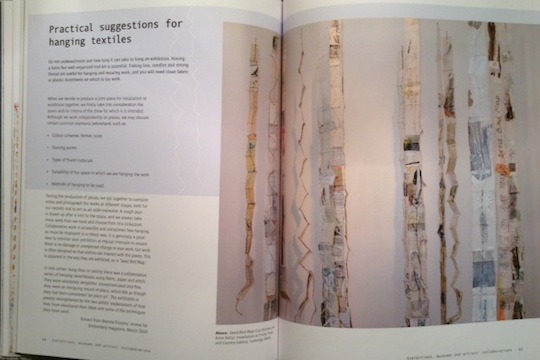
Free-hanging textile art
Conservation plays an important part in the display of textile pieces. It is crucial to consider where your work is going to be seen and what the conditions of that location are. If your work is free hanging it will need to be securely fastened to a wall or overhead support. This can be done effectively using fishing line, which is available in a variety of strengths.
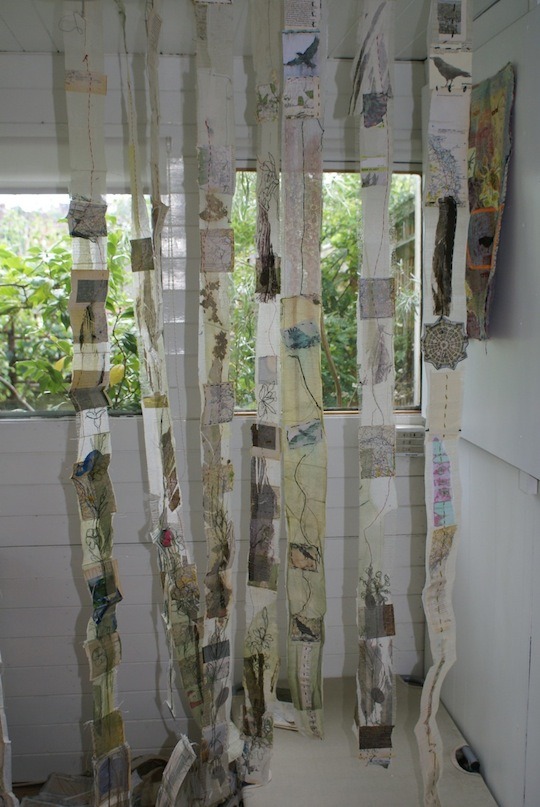

When hanging textile art, the line will need to be attached also to a vertical support which is suspended through your work to ensure that it hangs straight. A placket or narrow pocket running though the back of your piece can include a flat piece of wood or plastic, which can then be strung up using the fishing line.

I’ve recently started using electrical cable housing which can be bought cheaply online, as it is flat, light, rigid and straight.
How to frame textile art
If you feel that your work would be benefit from framing, there is also a minefield of options! The most conservation friendly method is to use acid free mounts and attachments; these and the frame would have to be built by a specialist framer. This can be pricey and is not always necessary.
It is always important to stress (when framing textile art) that your work should be hung away from moisture and direct sunlight, as you would always do for any art work. The presentation of your finished work is critical to the public perception of you as a textile artist. If your work is beautifully presented, potential purchasers are more likely and able to envisage it in their own surroundings and are more able to appreciate the work itself. Here is a photo from the same installation – looking beautiful.

Mounting textile art
Another option is a compromise but one which I think works quite well. You can mount your pieces onto blank canvases which are widely available in art and craft shops and online.
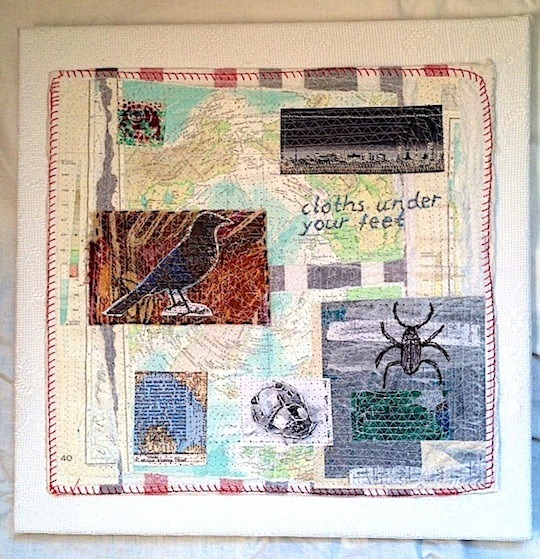
The work needs to be measured and made to fit the canvas size, with a 4-5cm border all the way around it. The work can then be positioned on the centre of the canvas and with the canvas turned upside down and the edges of the work can bestaple gunned into place. It is important to fold the edges of your work neatly, so that there are no bulges, especially with thicker fabrics.
Box framing is another pricey but effective option. Occasionally it is possible to find Box framing on the high street, and you would need to tailor make your piece to the size of the frame. The box should be deep enough to ensure that the glass does not touch the work, which can be attached to a piece of board using stitch or acid free tape. It gives a greater sense of depth and makes the work look like it is ‘floating’ if it is attached to a separate piece of card which can then be glued to the supported mounting board.
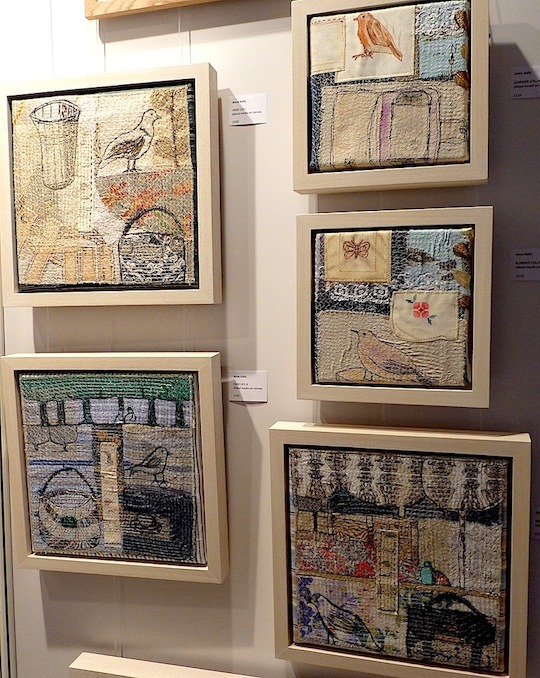
Displaying small pieces
Small pieces can be as challenging as larger ones to present, as the aim is to draw the viewer in for a closer look.
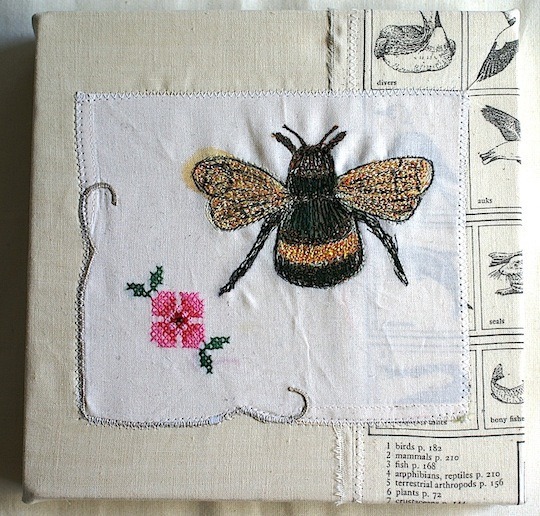
Suspending your work on fishing line or string, wool or thick cotton is a good option. The string will need to be sewn or tied through the work, and spacing it can be tricky, but it does look effective.

Check the gallery specifications
When you are displaying your work in a gallery, it is good practice to check the hanging system in advance and ensure that your work has the correct attachments before you install it. Security is a consideration and I would recommend public liability insurance for all exhibiting artists – most galleries insist on it. When exhibiting in a really large group, as in the recent small format challenge ‘Freedom, Freiheit, Liberte’, which has been touring Germany and Eastern Europe for over two years, the organiser will often take charge of the display. In this panel, Gudrun Heinz has sewn the contributions onto backing cloth in an effective arrangement.

It is important to measure up and visit your venue frequently before exhibiting as a site specific piece can be effective, as in this installation by Cas Holmes at Farnham Maltings gallery, as part of our joint exhibition ‘Natural Histories’.
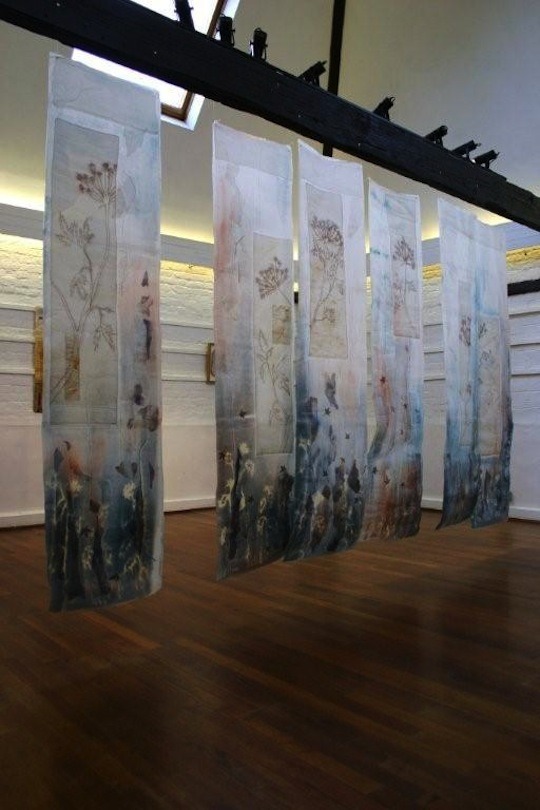
Often a variety of formats can also be effective, as shown at our later joint exhibition ‘Domestic Mapping’ at Maidstone Library Gallery, sadly no longer in use.
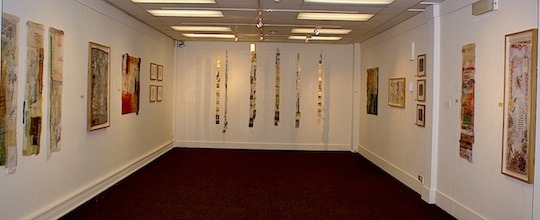
This mixed presentation was also effective and worked well at an artists open house ‘Polish and Pin’ in Hove.
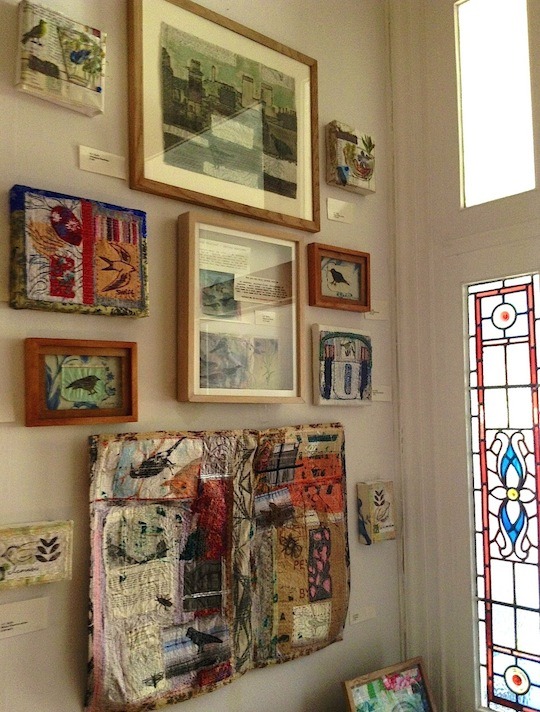
Displaying your work on a blank background or neutral cloth can be useful for photographing it and getting a sense of how you wish to present it.
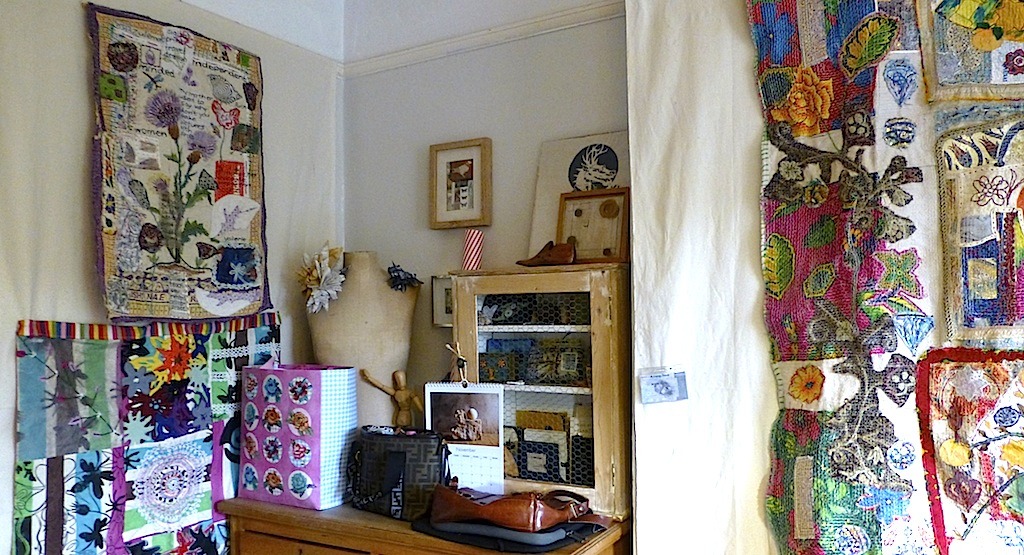
In this short piece, I have tried to share some observations from experience. There are many more ways of presenting your work and I hope this article will act as a forum for further discussion of the topic.
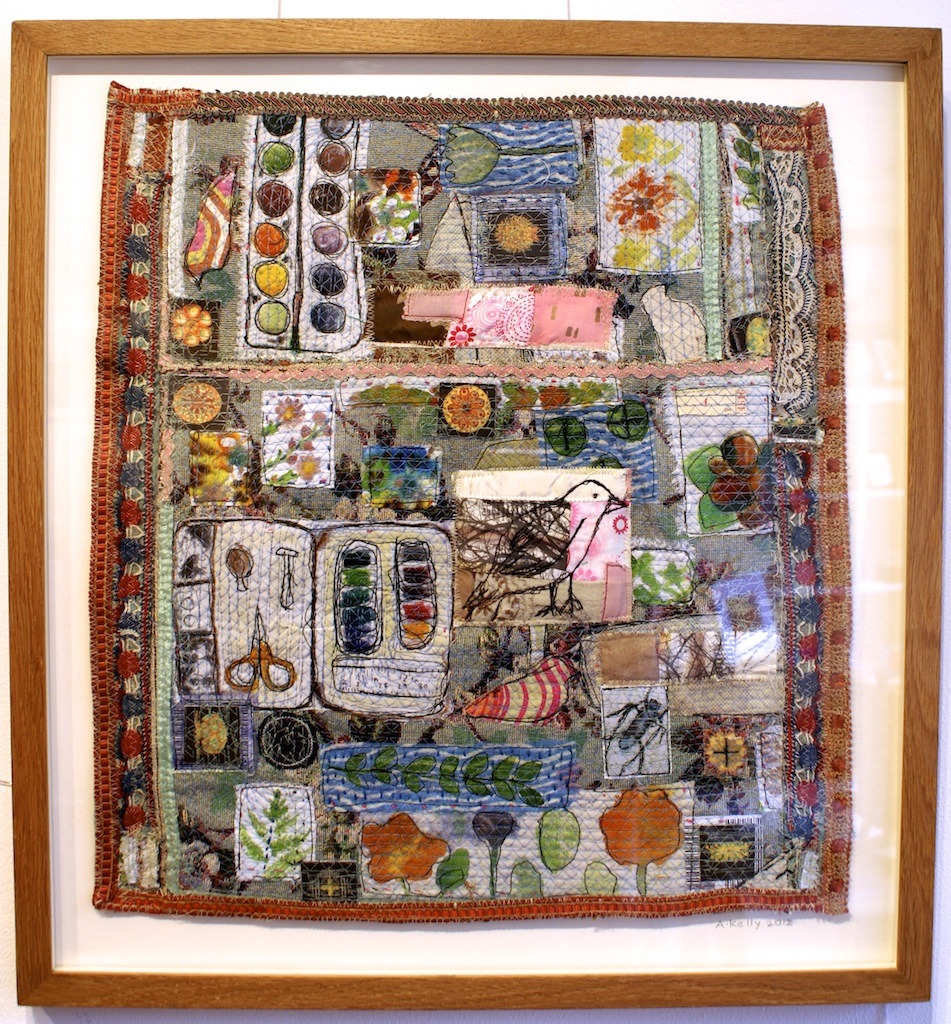
- Anne Kelly www.annekellytextiles.com is currently exhibiting at Trinity Town and Country Gallery, Tunbridge Wells, until September 29th. Go to www.trinitytheatre.net for opening times
- Anne Kelly and Cas Holmes’ first ‘Connected Cloth’ exhibition to coincide with the publication of their book, ‘Reflections’ is on at Cranbrook Library exhibition space until October 23rd. Go to www.cranbrook.org/library.php for opening times.
- You can see more about ‘Connected Cloth’ and the joint work of Cas Holmes and Anne Kelly on their blog resonanttextile.blogspot.co.uk.
Which methods do you prefer when hanging and displaying textile art? Let us and our readers know in the comments below.
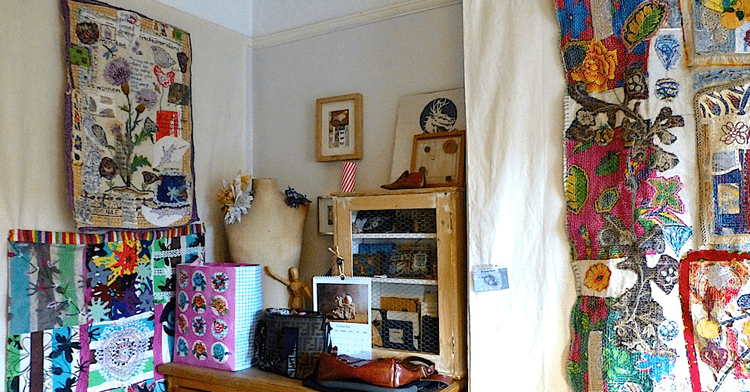

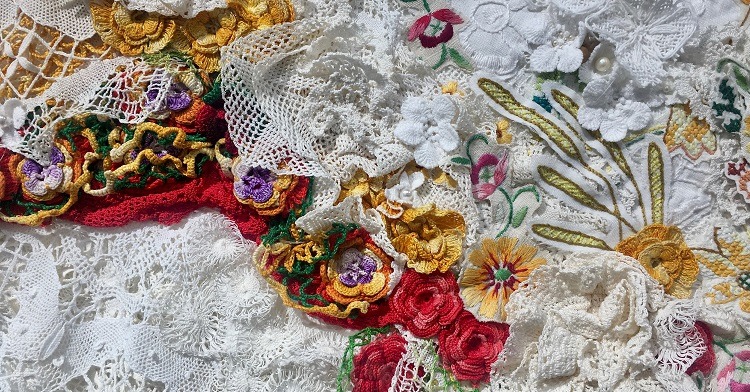
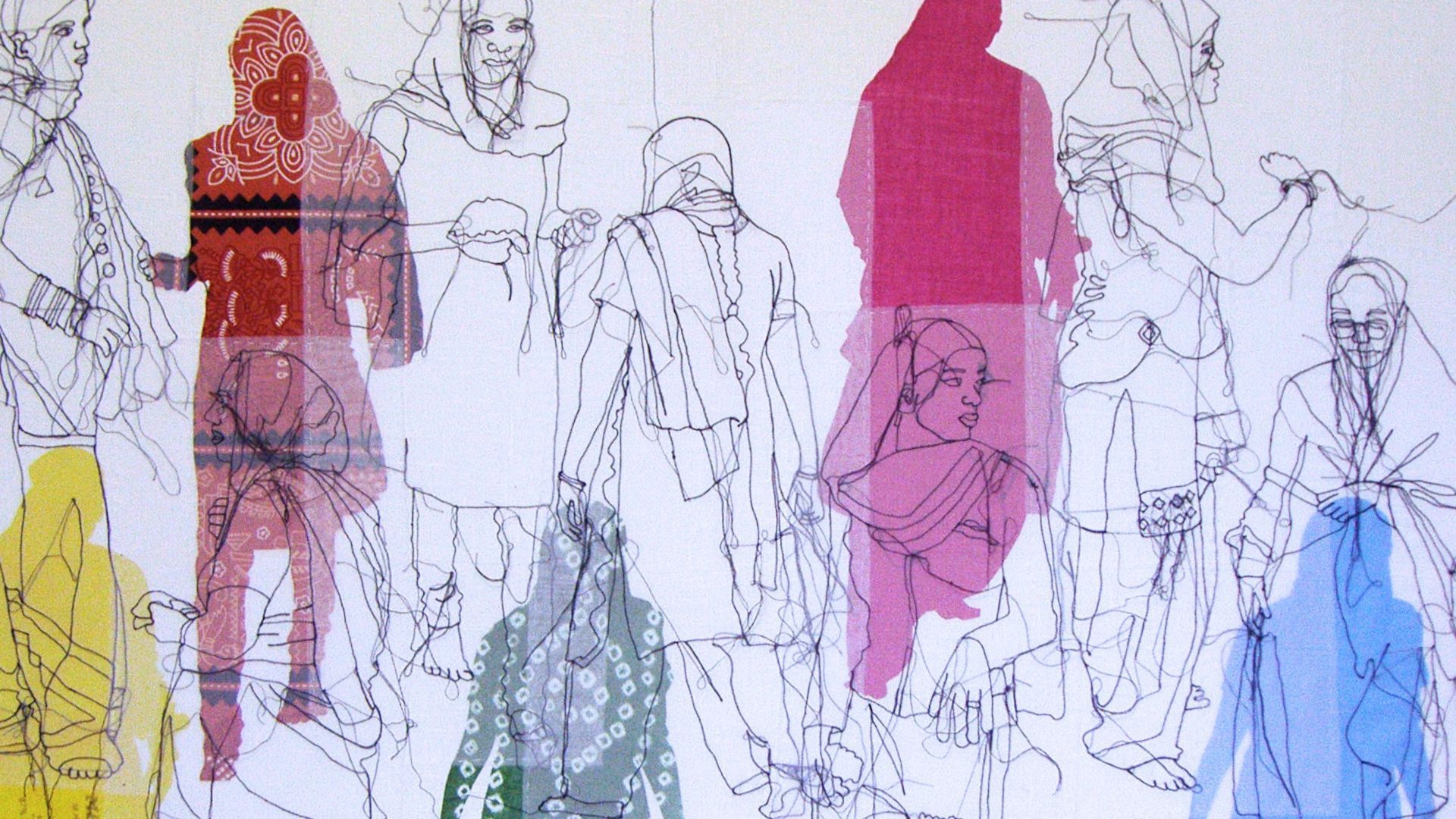

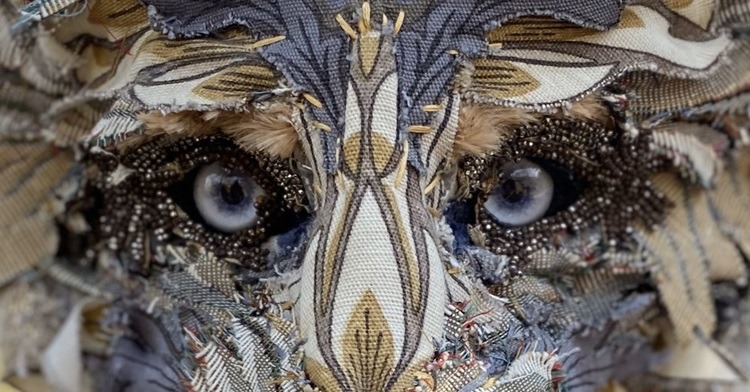
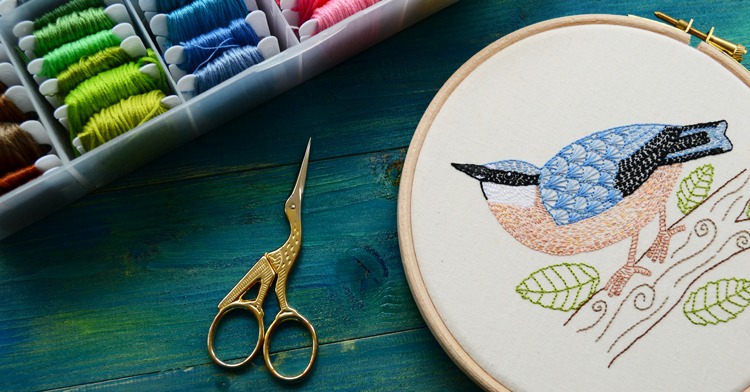
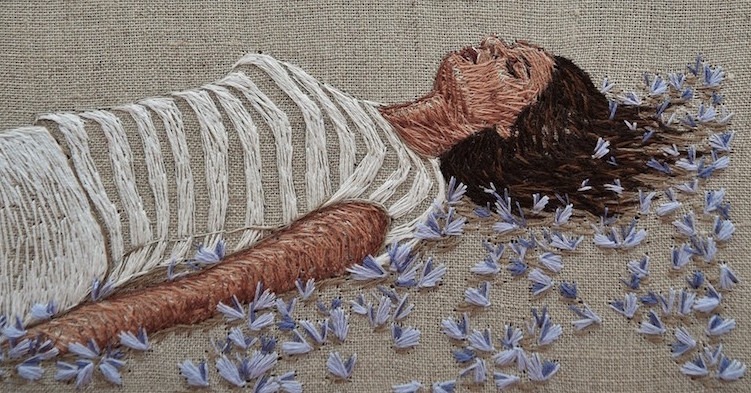
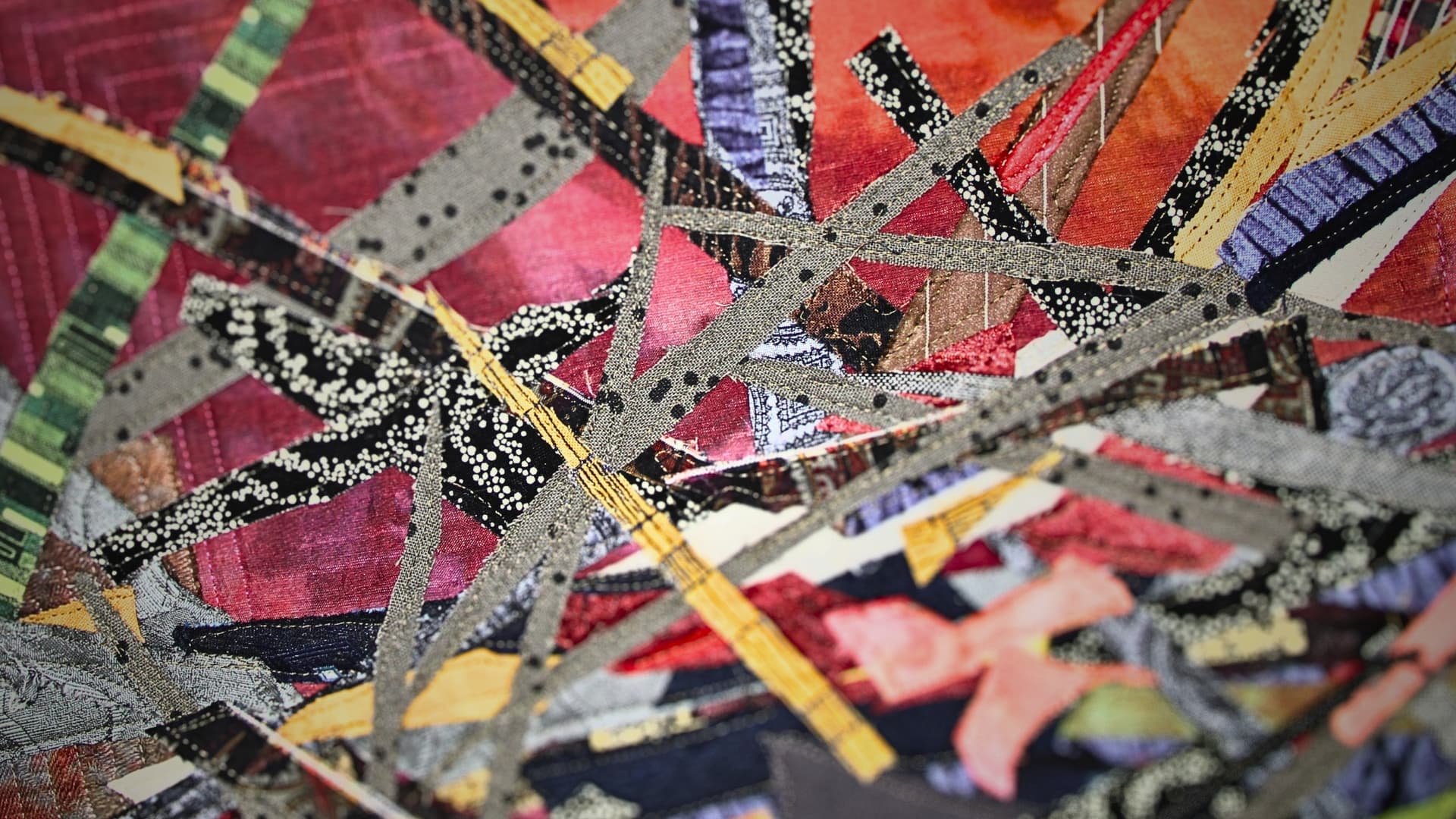
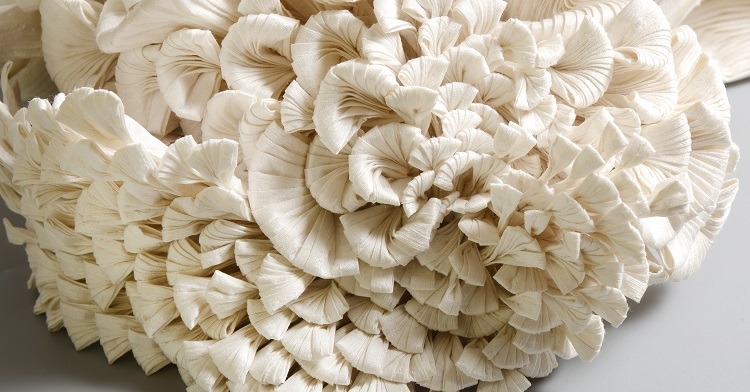
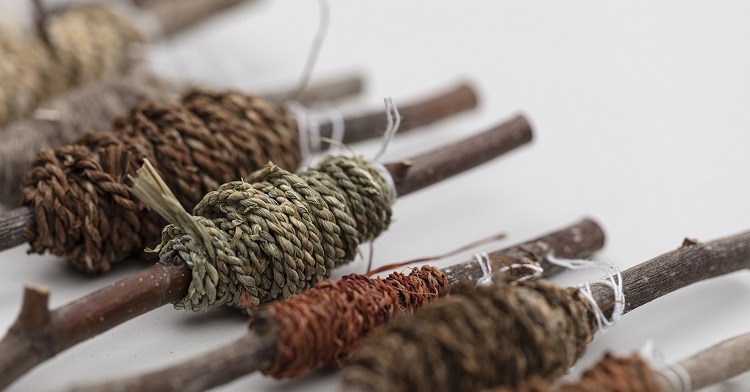
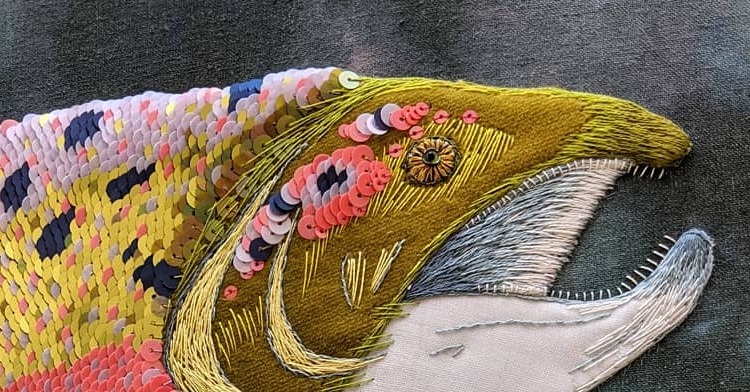
38 comments
GlamCrickee
Is Anne Kelly’s experience in curating reflected in her textile art, and how does it influence her creative process compared to other artists in the field?
Maria Khatun
Its such a great content. You should get a warm appreciation for this valuable content. Thanks
Rosateresa
Although the article and pictures are great, it needs close up pictures of the methods recommended for hanging. For example, what’s electrical cable housing? How does it look like?
amberley
Hello, electrical cable housing/conduit is a hollow tube used to organise cables. It’s available in a variety of thicknesses and can be purchased at most DIY retailers.
Textile Mentor
What a great article its always a difficult task to do I appreciate your hard work, keep uploading more, Thank you for sharing
Leslie Mixson
There was mention in the article of using electrical cable housing as support, but no source identified. Would love to know more about specific product used. Thanks so much
Cynthia Wood
How do you all respond to people who ask how to clean your fabric art if it hung freely and not under glass? Again, this is from people who are worried about dust collecting on the piece.
Sumon
Great post! Specially images are awesome.
Tomas Desuja
Awsome inspiring post, I already applied in my life. Thanks to @textileartist.
Tomas Desuja
Excellent inspiring post, I already applied in my real life. Thanks to @textileartist.
Mahedi Hasan
Just Amazing. Textile is an inevitable part of our life, especially this blog already highlights the artesian looks of conventional textile. Hats of to you guys @textile artist.
Linda
We have a painting done on fragile silk that we want to frame as a gift. How do we mount it so it won’t be damaged?
JFairweather
Something is missing, namely, how do you actually mount fabric art to something like mat board or canvas? I have a number of batiks that have the art right up to the edge and are not suitable for normal stretching / mounting via wax or staples. Do I use some sort of spray mount?
veronica aldous
You can fold it over the mat and stitch, lashing from one side to the other.
Sherry
We use a dry mount/vacuum press and acid free/archival mounting foam board, it takes several 2 minute sessions at 150 degrees, using a clean sheet of brown paper on top each time to absorb the excess wax, cut the foam board about a 1/4″ smaller than the edge of the batik, after this process you can float mount on mat board and shadow box frame it.
Janet Scruggs
I just wanted to let people know that you can use a few stitches to attach your artwork to painters canvas. I would do this instead of stapling. It only takes a couple of cross stitches in various places to hold your piece securely and it is often easy to hide those stitches with placement and a matching thread. I usually double up the thread or use a heavier weight thread.
veronica aldous
I rip all the canvas off a frame and stretch my piece over the bare stretcher using a staple gun and canvas pliers. That’s if I want to display and sell. I really fold everything up and put it in a bag! I do find the whole ‘making it into a picture thing’ annoying.
I don’t want them to be pictures! I want them to be stroked…My brain is working on this…
Chrissie Cleary
The dilemma of wanting your artwork to be touched and yet feeling the need to confine its innate tactility behind glass in order to appeal to prospective buyers. It is indeed true that many people do not appreciate ‘unprotected’ textile art because of dust issues (which are real.) What to do?
Janette Hamilton
Thank you so much for all the good suggestions, advice and practical know how you have given me. I have in the past use Ikea box frames (they have a variety of sizes) and now I have a better idea of using canvas I will give that a go. I live in a very remote part of Scotland there are no galleries in our small town (Campbeltown) but we do have a shop that’s sells locally made goods and I sell my work there. Take Care Janette
Janne Koerner
Very helpful!
Thelma
I’m involved with a gallery with a good hanging system for pictures, but it doesn’t work well for textiles. There are plastic wires attached to a rail at the top, and then the picture hangs from hooks which slide up and down the wires. The top of the frame doesn’t rest on the wall but the weight of it makes sure the bottom edge does. A textile which hangs flat to the wall at home hangs away from the wall using this system, which usually means it buckles or twists. It’s very frustrating ! As a cheap strengthener I sometimes use a channel along the bottom with a piece of scrap mountboard in it; that’s enough to stop the bottom corners from drifting in and if it gets bent by accident it’s easy to replace. Recently I’ve been using canvases painted with off-white emulsion and mounting my felt pieces by putting self-adhesive Velcro on the canvas. This has the advantage of not affecting the felt at all and it can be removed and conventionally framed if desired – you do hear people muttering ‘dust-collector’ !
Cheryl Karl
I’m excited by finding this website because I make quilted art that I plan to sell.
The one commenter talked about putting fabric behind glass. This is a good idea if the piece will live where there are
smokers….because I learned the hard way, cigarette smoke will destroy fabric pieces.
Michael Dickinson
Dear Ellen
Have a look at GluePirate.com it is a product made for mounting quilts but it may be useful
Chel Byrom
Ellen, Anne mentioned electrical trunking in the article. You can get it in d.i.y/hardware stores in differing thicknesses very cheaply. As stated, it is strong and rigid despite its lightness. Getting one length to experiment, running fishing line through it is a viable cost.
Great article, thanks, Anne.
Ellen M
Thank you so much for sharing your expertise – it’s a very helpful article.
Hanging large scale works straight is really challenging! I have a series of banners that are 3’x12′ and the only way I’ve been able to get them to hang straight and flat is to wrap the banner around layers of canvas and flannel. I tried fishing line and wooden sticks, but it still twisted and warped – even when the fabric is cut on grain.
Anyone come up with other ways to do this?
Onny
I love this ,,, thank you,
Love from Holland,
Onny de Bont
Liz Plummer
Displaying textile works is so challenging sometimes, isn’t it? We really do have to think outside the box! A few years ago I wrote a tutorial on how to mount small work on to foam core, though it could equally apply to the canvas wraps.
http://lizplummer.com/notable-posts/how-to-mount-a-small-quilt-on-to-foam-core/
Gill
Thank you Liz for sharing your technique – I was trying to figure out how to attach an art work to mount board without using tape so this is a great idea and so simple.
Jools x
Brilliant idea, Thank You so much,
naomi
Great idea!
vickybilton
Thanks….good advice
Jackie
Framing is so difficult. I tend to use blank canvases but cover them with an off white calico first then stitch the piece on through the back. I like the deep ones but if you use the thinner ones then a buyer could feasibly have it framed later. People seem to want to be able to frame things to ‘keep them clean’. I was once sitting in a cafe /gallery where I was exhibiting with a group. A couple of women walked along looking at them all until they got to some framed pieces. They said ‘You see these are alright because they’re behind glass’.
Diane Lawton
I loved looking at the seductive quality of the work displayed here. Thank you for the informative, thought provoking article. It has made me realise that I should be planning how and where to hang the piece in tandem to the overall choice of fabric, design elements, and execution.
One of my favorite textile books is Cas Holmes ‘The Found Object In Textile Art’. Now I’m going to order Connected Cloth.
Sam
Thanks Diane, we’re so pleased to hear that it was of help
may moe thu
I start to try fabric art I need to learn more n want to see art works
Daren Redman
The Walker Display System is great for exhibiting textiles. Check them out: http://www.walkerdisplay.com
Their products are made in the USA and are very affordable and interchangeable. Employees are great to work with and speedy!! dpr
Anne Kelly
Thanks for the additional suggestion Cas – very helpful.
cas holmes
Good article Anne. Thanks for sharing CC and images. I would add, check that the venue has no limitations on how they want you to hang your work as this could impact on the way your display the piece. ie in protected buildings etc.
all best Cas